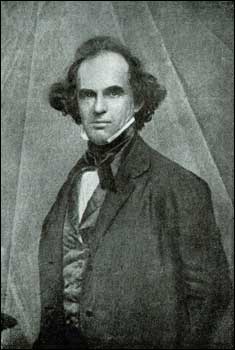Nathaniel Hawthorne
Nathaniel Hawthorne (July 4, 1804 – May 19, 1864) was an American novelist, dark romantic, and short story writer. His works often focus on history, morality, and religion. He is best known for his novels The Scarlet Letter (1850) and The House of the Seven Gables (1851).
Early Life[edit | edit source]
Nathaniel Hawthorne was born in Salem, Massachusetts, to Nathaniel Hathorne and the former Elizabeth Clarke Manning. His ancestors include John Hathorne, the only judge involved in the Salem witch trials who never repented of his actions. This family background influenced his writing, particularly his interest in the themes of sin and guilt.
Education[edit | edit source]
Hawthorne attended Bowdoin College in Brunswick, Maine, where he befriended future president Franklin Pierce and future poet Henry Wadsworth Longfellow. He graduated in 1825.
Literary Career[edit | edit source]
Hawthorne's first published work was a novel titled Fanshawe (1828), which he later tried to suppress. He published several short stories in various periodicals, which he collected in Twice-Told Tales (1837).
Major Works[edit | edit source]
- The Scarlet Letter (1850): This novel is set in 17th-century Puritan Massachusetts and tells the story of Hester Prynne, who conceives a daughter through an affair and struggles to create a new life of repentance and dignity.
- The House of the Seven Gables (1851): This novel is a Gothic story about the Pyncheon family, who live under a curse stemming from their ancestor's unfair acquisition of their land.
- The Blithedale Romance (1852): This novel is based on Hawthorne's experiences at the Brook Farm utopian community, and it explores the complexities of human nature and social reform.
- The Marble Faun (1860): This novel is set in Italy and combines elements of romance and travelogue, exploring themes of art, sin, and redemption.
Personal Life[edit | edit source]
In 1842, Hawthorne married Sophia Peabody, and they had three children: Una, Julian, and Rose. The family lived in Concord, Massachusetts, where they were neighbors to Ralph Waldo Emerson, Henry David Thoreau, and Louisa May Alcott.
Later Years and Death[edit | edit source]
Hawthorne was appointed the American Consul in Liverpool, England, by President Franklin Pierce, a position he held from 1853 to 1857. After returning to the United States, he continued to write until his health began to decline. He died on May 19, 1864, in Plymouth, New Hampshire, while on a tour of the White Mountains with Franklin Pierce.
Legacy[edit | edit source]
Nathaniel Hawthorne is considered one of the greatest American writers. His works are noted for their psychological depth and moral complexity. He has influenced numerous writers and remains a central figure in American literature.
Related Pages[edit | edit source]
- The Scarlet Letter
- The House of the Seven Gables
- Ralph Waldo Emerson
- Henry David Thoreau
- Louisa May Alcott
- Salem witch trials
- Brook Farm
- Bowdoin College
Categories[edit | edit source]
Search WikiMD
Ad.Tired of being Overweight? Try W8MD's physician weight loss program.
Semaglutide (Ozempic / Wegovy and Tirzepatide (Mounjaro / Zepbound) available.
Advertise on WikiMD
|
WikiMD's Wellness Encyclopedia |
| Let Food Be Thy Medicine Medicine Thy Food - Hippocrates |
Translate this page: - East Asian
中文,
日本,
한국어,
South Asian
हिन्दी,
தமிழ்,
తెలుగు,
Urdu,
ಕನ್ನಡ,
Southeast Asian
Indonesian,
Vietnamese,
Thai,
မြန်မာဘာသာ,
বাংলা
European
español,
Deutsch,
français,
Greek,
português do Brasil,
polski,
română,
русский,
Nederlands,
norsk,
svenska,
suomi,
Italian
Middle Eastern & African
عربى,
Turkish,
Persian,
Hebrew,
Afrikaans,
isiZulu,
Kiswahili,
Other
Bulgarian,
Hungarian,
Czech,
Swedish,
മലയാളം,
मराठी,
ਪੰਜਾਬੀ,
ગુજરાતી,
Portuguese,
Ukrainian
Medical Disclaimer: WikiMD is not a substitute for professional medical advice. The information on WikiMD is provided as an information resource only, may be incorrect, outdated or misleading, and is not to be used or relied on for any diagnostic or treatment purposes. Please consult your health care provider before making any healthcare decisions or for guidance about a specific medical condition. WikiMD expressly disclaims responsibility, and shall have no liability, for any damages, loss, injury, or liability whatsoever suffered as a result of your reliance on the information contained in this site. By visiting this site you agree to the foregoing terms and conditions, which may from time to time be changed or supplemented by WikiMD. If you do not agree to the foregoing terms and conditions, you should not enter or use this site. See full disclaimer.
Credits:Most images are courtesy of Wikimedia commons, and templates, categories Wikipedia, licensed under CC BY SA or similar.
Contributors: Prab R. Tumpati, MD







